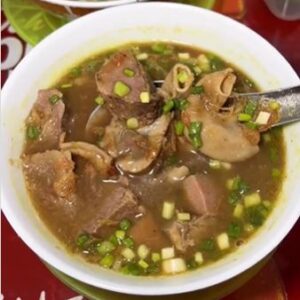KOMPAS.com – Yu Sheng, a typical Chinese New Year celebration salad, is not just an ordinary dish. This colorful salad symbolizes the good luck, hope and prosperity that will accompany the new year.
The tradition of eating Yu Sheng even involves special prayers that are full of meaning at every step.
Also read:
The various elements in Yu Sheng, from raw fish to crackers, have a deep philosophy that makes this dish so special.
Here are 10 interesting facts about Yu Sheng to know, quoted from the page Kompas.com.
1. Origins of Yu Sheng from Singapore
The Yu Sheng tradition was originally popularized by four chefs from Singapore in the 1960s. They developed this dish as an innovation from the Cantonese tradition of using sliced raw fish.
2. Colorful Symbols of Luck
Each ingredient in Yu Sheng has bright colors such as red, yellow, and green which symbolize good luck, happiness, and abundance. These colors are believed to bring luck throughout the year.
3. Prayers and Mantras in Every Step
Yu Sheng’s eating tradition involves saying prayers at every step, from “Gong Xi Fa Cai” to “Chai Yuen Kwang Gin.” These prayers are a symbol of hope for sustenance, happiness and success.
4. Raw Fish as a Symbol of Abundance
Raw fish such as salmon or tuna are used in Yu Sheng. In tradition, this fish symbolizes abundance and prosperity throughout the new year.
5. Sesame Oil for Flowing Fortune
Sesame oil poured in a circular motion symbolizes good fortune that continues to flow endlessly. This stage is usually accompanied by the words “Cai Yuen Kwang Gin.”
6. Crackers are a symbol of luxury
Crackers or fried dumpling skins in Yu Sheng symbolize gold. The addition is accompanied by the prayer “Bian Ti Hwang Cin,” which means luxury and blessing.
7. Unique Way of Eating
Yu Sheng stirred it together using long chopsticks, then lifted it as high as possible. The higher the salad is raised, the greater the hope for good luck in the new year.
8. Philosophy Behind Each Ingredient
Each Yu Sheng ingredient has a philosophical meaning, such as carrots for good luck, peanuts for wealth, and sesame for blessings. All these elements create a harmony of flavor and symbolism.
9. Happiness Sharing Dish
Yu Sheng is usually served on a large plate and eaten with the whole family. This symbolizes togetherness, blessings, and hope for a better year.
10. Popularity Outside China
Even though it comes from Chinese tradition, Yu Sheng is better known in Singapore, Malaysia and Indonesia. Restaurants in this country often serve Yu Sheng as a special menu during Chinese New Year.
Listen breaking news And selected news we’re right on your phone. Choose your favorite news channel to access Kompas.com WhatsApp Channel: https://www.whatsapp.com/channel/0029VaFPbedBPzjZrk13HO3D. Make sure you have installed the WhatsApp application.






